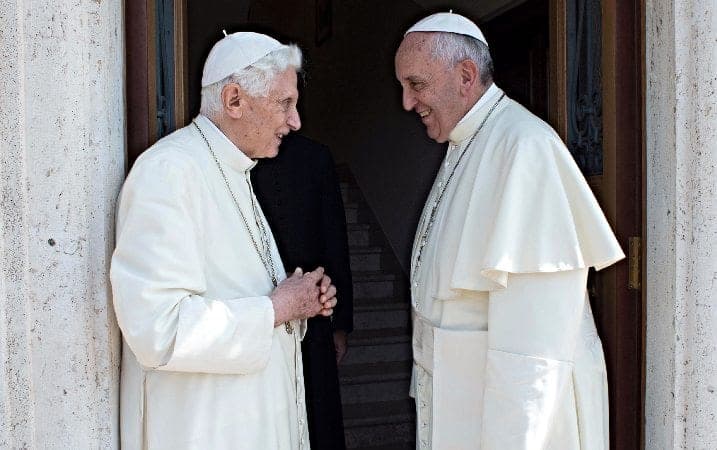Arthur Schlesinger once said that President John F. Kennedy could look at all the polling numbers he wanted, but he didn’t really grasp how deep public support was for a nuclear test ban treaty until he hit the road and heard from the crowds.
Surveys are useful for assessing opinion, but to gauge intensity and depth of feeling, sometimes a leader needs to see for him or herself how real people react.
A similar point could be made with St. Pope John Paul II and ecumenism. The pontiff was already firmly committed to closer ties with other Christians by 1999, but when he traveled to overwhelmingly Orthodox Romania that year and was greeted by large crowds enthusiastically chanting unitate! unitate!, meaning “unity,” it helped drive home that this wasn’t just a theological or academic undertaking, but a transcendent popular cause.
The lesson is that crowds sometimes teach things polls can’t, perhaps not so much about what people think, but how passionately they’re thinking it.
That insight comes to mind in light of a new Italian biography of emeritus Pope Benedict XVI to be published Aug. 30 called Servant of God and of Humanity, written by theologian and historian Elio Guerriero.
The book carries an original preface by Pope Francis, which was published Wednesday by the newspaper of the Italian bishops’ conference. In it the pontiff reflects, among other things, on what he sees as the blessing of having Benedict around.
“His discrete presence and his prayer for the Church are a continual support and comfort for my service,” Francis writes.
“Who better than him can understand the joys, and also the difficulties, of service to the universal Church and the world of today, and be spiritually close to the one called by the Lord to carry that weight?” Francis asks, obviously rhetorically.
“For that reason, his prayer is especially precious, and his friendship especially appreciated,” the pope says.
Francis goes on to say that the situation the Church finds itself in today of having two living popes, one in office and the other emeritus, is a “novelty.” He doesn’t add, perhaps because he didn’t need to, that it’s a novelty not everyone finds entirely satisfying.
From the beginning, there have been critics of the arrangement. Some argued that because there can be only one pope at a time, the right thing for Benedict to do would have been to renounce all insignia and titles associated with the office and return to being Cardinal Joseph Ratzinger.
Others feared that having a retired pope around would be divisive and destabilizing, as critics of the new pope would rally around the old one.
Certainly there has been a bit of that in some quarters, and there are still some writers and theologians to this day who question the validity of Benedict’s resignation and thus whether Francis is actually a legitimate pope. To his credit, Benedict has never played that game, professing his support for Francis at every turn and otherwise staying out of the fray.
There were howls of protest recently when Archbishop Georg Gänswein, Benedict’s long time aide, made the seemingly common-sense suggestion that the new situation implies an expanded Petrine ministry, with an active member and a contemplative one. Some appeared to see it almost as the prelude to a putsch, if not a schism.
Francis is obviously aware of that reaction, and in effect his preface to the new Benedict biography delivers his response.
“Since they love each other,” Francis says of having two popes, “it’s a beautiful novelty.”
“In a certain sense,” he says, “it expresses in a particularly clear way the continuity of the Petrine ministry, without interruption, like links in a single chain forged by love.”
Then, Francis comes to what he apparently sees as the popular bottom line.
“The holy people of God, on the path, have understood this very well,” he asserts.
In terms of how he knows what people think, here’s what he says: “Every time the emeritus pope has appeared in public, at my invitation, and I was able to embrace him in front of everyone, the joy and the applause of those present has been sincere and intense.”
Francis’ conviction seems to be that while theologians, ecclesiologists and bloggers may be perplexed or perturbed, the ordinary people of God aren’t. They love Benedict just as they love Francis, in part for who they are, but perhaps even more for what they represent.
They also love seeing the two men together, as a sign of unity and spiritual kinship that cuts far deeper than the politics of the moment, and their reaction whenever it happens in public confirms the point.
In effect, Francis is saying that the people have spoken, and what they’ve said is that having two popes around is just fine.
For the record, Francis also, for the umpteenth time, rejects the idea that there’s any break between his papacy and Benedict’s, arguing that both, as with the other recent papacies, ultimately pivot on the loving mercy of God, calling it “the most urgent message of a Church reaching out, even to the peripheries, of a world marked by conflicts, injustices and disrespect for the human person.”
“The entire life of thought and works of Joseph Ratzinger has aimed at that end, and in the same direction, with the help of God, I’ll try to continue,” he said.
While that may not be enough to satisfy all the critics of the two-pope arrangement, one in charge and the other at prayer, it seems more or less like Francis’ final verdict.














